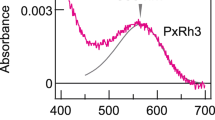Summary
The photochemical cycle of the visual pigment molecules in the blowflyCalliphora erythrocephala was investigated by transmission measurements, making use of the fact that intermediate states of the visual pigment molecules each have a characteristic absorption spectrum.
It is shown that the conversion of metaxanthopsin (M 580) to the native xanthopsin state (P 490) induced by an orange-red light pulse proceeds through a newly discovered intermediate (N), which thermally decays with a time constant of about 13 ms at room temperature.
The absorption spectrum of N peaks in the blue-green at about 490 nm. In the green and orange N absorbs more strongly than the native xanthopsin, but in the blue N and xanthopsin absorb almost equally. The latter finding explains why N has remained undetected in earlier studies.
Similar content being viewed by others
Abbreviations
- ERP :
-
early receptor potential
- M :
-
metaxanthopsin
- P :
-
xanthopsin
References
Bentrop J, Paulsen R (1986) Light-modulated ADP-ribosylation, protein phosphorylation and protein binding in isolated fly photoreceptor membranes. Eur J Biochem 161:61–67
Franceschini N, Kirschfeld K (1971) Les phénomènes de pseudopupille dans l'oeil composé deDrosophila. Kybernetik 9:159–182
Gagné S, Roebroek JGH, Stavenga DG (in press) Enigma of early receptor potential in fly eyes resolved. Vision Res
Hamdorf K (1979) The physiology of invertebrate visual pigments. In: Autrum H (ed) Vision in invertebrates (Handbook of sensory physiology, vol VII/6A). Springer, Berlin Heidelberg New York, pp 145–224
Hateren JH van (1984) Waveguide theory applied to optically measured angular sensitivities of fly photoreceptors. J Comp Physiol A 154:761–771
Kirschfeld K, Feiler R, Minke B (1978) The kinetics of formation of metarhodopsin in intact photoreceptors in the fly. Z Naturforsch 33 c: 1009–1010
Kruizinga B, Kamman RL, Stavenga DG (1983) Laser induced visual pigment conversions in fly photoreceptors measured in vivo. Biophys Struct Mech 9:299–307
Minke B, Kirschfeld K (1979) The contribution of a sensitizing pigment to the photosensitivity spectra of fly rhodopsin and metarhodopsin. J Gen Physiol 73:517–540
Minke B, Kirschfeld K (1980) Fast electrical potentials arising from activation of metarhodopsin in the fly. J Gen Physiol 75:381–402
Paulsen R, Bentrop J (1984) Reversible phosphorylation of opsin induced by irradiation of blowfly retinae. J Comp Physiol A 155:39–45
Schwemer J (1979) Molekulare Grundlagen der Photorezeption der SchmeissfliegeCalliphora erythrocephala Meig. Habilitationsschrift, Bochum
Stark WS, Stavenga DG, Kruizinga B (1979) Fly photoreceptor fluorescence is related to UV sensitivity. Nature 280:581–583
Stavenga DG (1975a) Optical qualities of the fly eye — an approach from the side of geometrical, physical and waveguide optics. In: Snyder AW, Menzel R (eds) Photoreceptor optics. Springer, Berlin Heidelberg New York, pp 126–144
Stavenga DG (1975b) Derivation of photochrome absorption spectra from absorbance difference measurements. Photochem Photobiol 21:105–110
Stavenga DG, Schwemer J (1984) Visual pigment of invertebrates. In: Ali MA (ed) Photoreception and vision in invertebrates. Plenum, New York, pp 11–61
Stephenson RS, Pak WL (1980) Heterogenic components of a fast electrical potential inDrosophila compound eye and their relation to visual pigment conversion. J Gen Physiol 75:353–379
Tsuda M, Tokunaga F, Ebrey TG, Yue KT, Marque J, Eisenstein L (1980) Behaviour of octopus rhodopsin and its photoproducts at very low temperatures. Nature 287:461–462
Vogt K (1983) Is the fly visual pigment a rhodopsin? Z Naturforsch 38 c:329–333
Vogt K, Kirschfeld K (1984) Chemical identity of the chromophores of fly visual pigment. Naturwissenschaften 71:211–213
Author information
Authors and Affiliations
Rights and permissions
About this article
Cite this article
Roebroek, J.G.H., Gagné, S. & Stavenga, D.G. Photoreconversion of blowfly visual pigment proceeds through a slowly (13 ms) decaying intermediate. J. Comp. Physiol. 165, 75–81 (1989). https://doi.org/10.1007/BF00613801
Accepted:
Issue Date:
DOI: https://doi.org/10.1007/BF00613801




